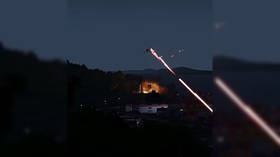Game footage being shared as ‘Ukraine videos’


Several videos which have made their way around social media described as footage of the ongoing military conflict in Ukraine have been debunked as clips taken from games.
A report by Bloomberg has revealed that some of the most-viewed videos on Facebook’s gaming channel were clips that were being spread as on-the-ground footage of military action in Ukraine. The videos were reportedly viewed by more than 110,000 people and shared over 25,000 times before they were taken down. Nevertheless, they made their way to other social media platforms, being spread around with titles such as ‘Ukraine fires missiles to intercept Russian aircraft’s artillery fire’ and ‘Intense dogfight in the skies of Ukraine’.
The first video which went viral on Thursday purportedly showed a military plane performing a bombing run while dodging fire from AA defense systems. However, the video turned out to be footage from the ‘Arma III’ military simulator game.
Another clip made the rounds on social media on Friday, supposedly showing a combat engagement between a Ukrainian MiG-29 and a Russian SU-35, with the latter being destroyed by a missile. The video went viral on social media, including English-speaking Twitter, with a caption praising the “ghost of Kiev” - a supposed pilot of Ukraine’s Air Force that has “managed to single-handedly take down 6 Russian fighter jets,” even spawning several comic strips. However, the footage was soon revealed to be a clip from ‘Digital Combat Simulator’, with the author of the original clip explicitly stating it was made in ‘DCS’.
It’s hard to deny the videos do look realistic at first glance, which makes it understandable why many take such posts at face value and are quick to share them around, however it highlights a long standing problem where unverified videos provided with little to no context or research end up being spread throughout social media and even used by news channels and government agencies, like, for example, when the Russian MoD used an image from ‘Arma III’ in a report on Syria in 2019 or when CNN showed clips from a ‘Fallout’ game in a segment about Russian hacking in 2016.